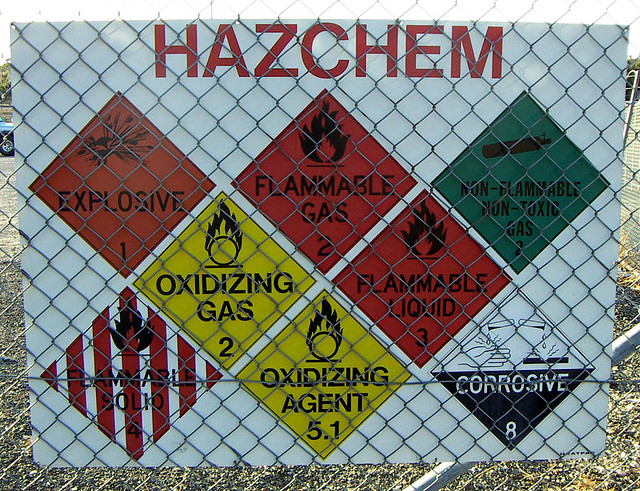In 2007, Congress added a provision to the Department of Homeland Security (DHS) budget, directing DHS to create a program to identify chemicals that might be tempting targets for terrorists, and to require facility that handle sufficiently large quantities of these chemicals of interest to establish security programs subject to DHS oversight (“Section 550”). DHS responded to Section 550 by issuing Chemical Facility Anti-terrorism Standards (CFATS) rules, requiring compliance to begin in 2008.
Audit, Compliance and Risk Blog
Congress Updates Chemical Facility Anti-Terrorism Standards
Posted by Jon Elliott on Mon, Feb 02, 2015
Tags: Corporate Governance, Business & Legal, Employer Best Practices, Health & Safety, Environmental risks, Environmental, Hazcom, Workplace violence
Reconsidering External Threats From Terrorists and Other Criminals
Posted by Jon Elliott on Tue, Oct 28, 2014
Although most “workplace violence” incidents are low-level psychological or physical altercations between co-workers, Canadians have just been tragically reminded of the dangers of murders by interlopers. Government buildings are the likeliest targets for terrorism, and financial and retail buildings the likeliest targets for non-political criminals, but all workplaces face at least some of these most severe risks. There’s no way to eliminate these risks, but commonsense workplace security measures can reduce them. This note discusses approaches to evaluating and reinforcing security against external threats – which are important subsets of broader workplace violence prevention efforts.
Tags: Corporate Governance, Business & Legal, Employer Best Practices, Health & Safety, Employee Rights, Workplace violence
Four Management Approaches to Workplace Violence Prevention
Posted by Steve Albrecht on Mon, Jun 23, 2014
The best strategies for workplace violence prevention involve updated and enforced company policies; an awareness that real perpetrators don’t necessarily make direct threats to their targets; and the creation of Threat Assessment Teams to manage situations successfully. These four management interventions can help those efforts as well.
Tags: Corporate Governance, Business & Legal, Employer Best Practices, Employee Rights, Training, Workplace violence
When you think of dangerous industries to work in, which ones come to mind? Construction, mining, longshoring, maybe even letter carrying, are obvious, but did healthcare make the list?
Tags: Employer Best Practices, Health & Safety, OSHA, Employee Rights, Training, EHS, Workplace violence
Employers in the United States must verify that new hires are eligible to work in the U.S. This responsibility was created by the Immigration Reform and Control Act (IRCA) of 1986, which drafted employers—on pain of being prosecuted themselves—into partnership with the federal government to deny job opportunities to unauthorized workers. Employers' compliance responsibilities are based on use of the I-9 Form ("Employment Eligibility Verification") issued by U.S. Citizenship and Immigration Services (USCIS). As information technology develops, USCIS has expanded electronic reporting and data management tools, the most important of which is called E-Verify. Both I-9's and E-Verify continue to evolve, and have received recent revisions.
Tags: Corporate Governance, Business & Legal, Employer Best Practices, Employee Rights, Workplace violence, Internet
Workplace Bullying and Harassment: New Rules for British Columbia
Posted by Jon Elliott on Mon, Oct 28, 2013
Workers throughout the United States and Canada are protected by occupational health and safety laws, administered by federal, and state or provincial worker safety agencies—such as the U.S. Occupational Safety and Health Administration and the Workers' Compensation Board of British Columbia (WorkSafeBC). Most of these agencies recognize workplace violence as a potential hazard, although regulatory requirements associated with this hazard vary considerably among jurisdictions. Effective November 1, 2013, British Columbia supplements its longstanding workplace violence prevention requirements with requirements for "all reasonable steps to prevent where possible, or otherwise minimize, workplace bullying and harassment." BC provides separate, complementary rules for:
Tags: Corporate Governance, Business & Legal, Employer Best Practices, Employee Rights, Training, Workplace violence, Canadian
"Supervisors” Whose Discrimination Automatically Involves Employers
Posted by Jon Elliott on Wed, Jul 10, 2013
Title VII of the Civil Rights Act of 1964 provides a wide range of anti-discrimination measures, including prohibitions against employment discrimination based on race, color, religion, sex (or “gender”), and national origin. Title VII is administered by the Equal Employment Opportunity Commission (EEOC), and enforced when EEOC or aggrieved employees file lawsuits in federal court.
Tags: Corporate Governance, Business & Legal, Employer Best Practices, Employee Rights, Workplace violence, EEOC, NLRB
We’ve all just received a grim reminder how easily public celebrations can become public nightmares. Readers who may now be nervous about special events in their areas should know that law enforcement and security professionals have developed security protocols that formalize hazard assessment and management. One important template for such protocols was published in 2007 by the U.S. Department of Justice (DOJ) – Planning And Managing Security For Major Special Events: Guidelines for Law Enforcement.
Tags: Corporate Governance, Employer Best Practices, Employee Rights, Workplace violence
Violence Against Women Act: Expanded Security Requirements On Campus
Posted by Jon Elliott on Tue, Mar 26, 2013
Earlier this month, President Obama signed the Violence Against Women Reauthorization Act of 2013, which renews and revises a wide variety of federal regulatory and grant programs intended to reduce gender-related violence against women. Although many of these protective measures are workplace-related, the amendments also expand protections for students at 99% of the nation’s colleges and universities (those that receive “Title IV” money from the U.S. Department of Education). These schools must comply with the Jeanne Clery Disclosure of Campus Security Policy and Campus Crime Statistics Act (Clery Act) by providing an Annual Security Report each October 1.
Tags: Employer Best Practices, Health & Safety, Workplace violence
Employment Law: Are All Workplace Liaisons Dangerous Liaisons?
Posted by Jon Elliott on Mon, Jan 28, 2013
Everyone has relationships in the workplace. Many relationships are purely professional, while some add personal elements, and one or more may even be very personal. Anti-discrimination laws may impose scrutiny on any relationship where at least one person is a manager or supervisor, or the owner of a small enterprise. In the U.S. these include laws (including Title VII of the federal Civil Rights Act of 1964, and comparable state laws), regulations and enforcement guidelines (from by the Equal Employment Opportunity Commission (EEOC) and state equivalents), and court cases applying these standards. In Canada these include comparable human rights and occupational health and safety regimes.
Tags: Corporate Governance, Business & Legal, Employer Best Practices, Employee Rights, Workplace violence, EEOC, NLRB










